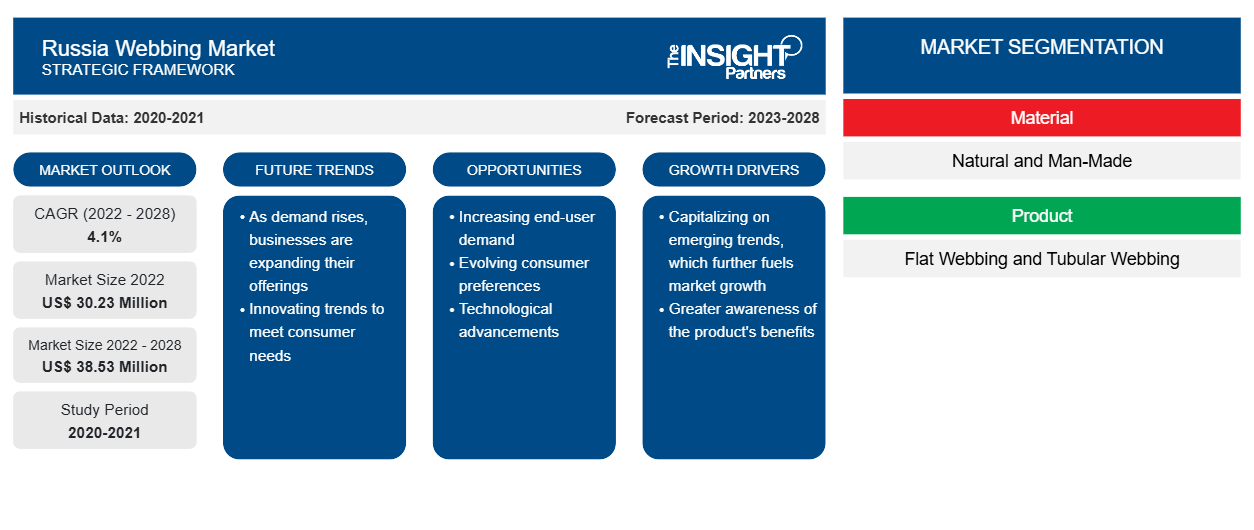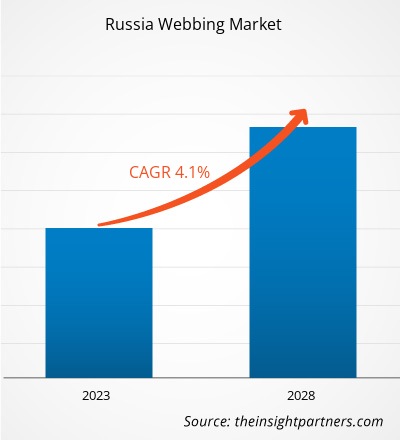The Russia webbing market is expected to grow from US$ 30.23 million in 2022 to US$ 38.53 million by 2028. It is expected to grow at a CAGR of 4.1% from 2022 to 2028.
MARKET ANALYSIS
Webbings are used in several end-use industries, including aerospace, automotive, military, industrial, fashion, e-textile, sports goods, marine, and healthcare. In the automotive industry, webbing is mainly used for manufacturing airbags, safety harnesses, catch belts, seat belts, and luggage nets. Webbing is commonly used in doorknobs and boot/hatchback handles in cars. Webbing is used to produce a wide range of military products, such as military belts, packs, and pouches. Webbing is used in various civilian safety applications, such as chin and shoulder straps, lap belts, harnesses, and binding tapes.
GROWTH DRIVERS AND CHALLENGES
The government's focus on scaling up automotive production across the globe has aided the webbing market growth. The automotive industry in Russia produces passenger vehicles and light and heavy commercial vehicles. The country exports vehicles to various European and Asian countries. The country's automotive industry employs ~300,000 people. Russia is devising a strategy to make its automotive industry more self-sufficient. According to the government, the main objectives of the new strategy are to stimulate demand for cars among Russian consumers and to achieve 80% localization of vehicle and vehicle components production. In the automotive industry, webbing is highly used in applications such as seat belts, safety harnesses, towing straps, binding for luggage nets, and pull straps. Webbing is also used in door handles or boot/hatchback handles. In the automotive industry, nylon, polypropylene, and polyester webbings are commonly used in applications such as airbag tethers, battery straps, boot lining assemblies, and car mat bindings. Hence, the government's focus on ramping up automotive production bolsters the Russia webbing market size in the country. Regulations and standards about webbing manufacturing pose a challenge to the webbing market. Webbing manufacturers must conform to several regulatory standards to guarantee product quality and customer safety. European standard BSEN 1492:1 relates to flat woven webbing slings for general-purpose applications, such as lifting equipment. Ensuring compliance with domestic and international regulations and standards for webbing adds to the overall cost of the manufacturing process, thereby restraining the growth of the Russia webbing market.
Customize This Report To Suit Your Requirement
You will get customization on any report - free of charge - including parts of this report, or country-level analysis, Excel Data pack, as well as avail great offers and discounts for start-ups & universities
Russia Webbing Market: Strategic Insights

- Get Top Key Market Trends of this report.This FREE sample will include data analysis, ranging from market trends to estimates and forecasts.
You will get customization on any report - free of charge - including parts of this report, or country-level analysis, Excel Data pack, as well as avail great offers and discounts for start-ups & universities
Russia Webbing Market: Strategic Insights

- Get Top Key Market Trends of this report.This FREE sample will include data analysis, ranging from market trends to estimates and forecasts.
REPORT SEGMENTATION AND SCOPE
The "Russia Webbing Market Analysis to 2028" is a specialized and in-depth study with a major focus on the market trends and growth opportunities in Russia. The report aims to provide an overview of the Russia webbing market with detailed market segmentation by material, product, end use, and geography. The Russia webbing market has been witnessing high growth in the recent past and is expected to continue this trend during the forecast period. The report provides key statistics on the consumption of webbing, along with its demand in major regions and countries. In addition, the report provides a qualitative assessment of various factors affecting the webbing market performance in major regions and countries. The report also includes a comprehensive analysis of the leading players in the webbing market and their key strategic developments. Several analyses on the market dynamics are also included to help identify the key driving factors, market trends, and lucrative opportunities that would, in turn, aid in identifying the major revenue pockets.
Further, ecosystem analysis and Porter's five forces analysis provide a 360-degree view of the Russia webbing market, which helps understand the entire supply chain and various factors affecting the market growth.
- This FREE sample will include data analysis, ranging from market trends to estimates and forecasts.
SEGMENTAL ANALYSIS
The Russia webbing market is segmented based on material, product, and end use. Based on raw material, the Russia webbing market is segmented into natural and man-made. In terms of product, the Russia webbing market is classified into flat webbing and tubular webbing. Based on end use, the Russia webbing market is categorized into aerospace, automotive, military, industrial and safety, fashion accessories, e-textile, sport goods, marine, medical, and others. Based on material, the man-made segment accounted for a significant share contributing to the Russia webbing market. Man-made webbing made from polyester is commonly utilized in applications with low to high load-bearing capacity. Natural webbing materials include cotton, linen, jute, bamboo, and hemp. It is a natural textile offering an alternative to nylon and polyester webbings. Based on product, flat webbing accounted for a major share, owing to a wide range of applications. Flat webbing is suitable for applications where the material can be entwined into a larger product, such as backpack straps, reinforcing bindings, and seatbelts. Tubular webbing is softer and more pliable than flat webbing. With a tensile strength of 4,000 lbs, tubular webbing offers a higher overall strength per inch. Based on end use, the aerospace segment accounted for a significant market share. Webbings are widely used in crucial aerospace industry applications such as parachutes, cargo restraint systems, and seating, as well as in interior applications, including crew safety system components, flight suits, air slides, and seatbelts. In the automotive industry, webbing is mainly used for manufacturing airbags, safety harnesses, catch belts, seat belts, and luggage nets. Webbing is used in the military to produce a wide range of products, such as military belts, packs, and pouches. Webbing is used in a range of safety applications, making testing and quality control an essential element of the manufacturing process.
REGIONAL ANALYSIS
The report provides a detailed overview of the Russia webbing market size. Russia has been experiencing industrial expansion in sectors such as building & construction, aerospace, military, manufacturing, automotive, and marine. These sectors require webbing materials for applications such as lifting slings, cargo securing, safety harnesses, and material handling equipment, which is driving the demand for webbing products. The strong presence of automotive and aerospace manufacturing bases in the country drives the demand for webbing, as several types of webbing and straps are used in automotive and aerospace industries. In the automotive industry, webbing is used for applications such as airbag tethers, battery straps, car mat bindings, and door tethers. In the aerospace industry, webbing is used in applications such as parachutes, flight suits, seat belts, seat construction, and crew safety system components. The Russia webbing market is also driven by industries such as sporting goods, fashion, medicine, and marine. Considerable growth in the Russia webbing market size is witnessed, valued at more than US$ 25.0 million in 2022. This can be attributed to the strong presence of automotive, aerospace, and military industries in the country.
INDUSTRY DEVELOPMENTS AND FUTURE OPPORTUNITIES
The report provides a detailed overview of the Russia webbing market with respect to five major regions: North America, Europe, Asia Pacific (APAC), Middle East & Africa (MEA), and South & Central America.
- In January 2020, E. Oppermann GmbH opened Oppermann Vietnam Ltd. This 4th Asian location represents an important key component in the strategic corporate development of the company.
- In September 2019, Bally Ribbon Mills introduced E-WEBBINGS e-textile product base, specifically designed to serve as a customizable base for a wide range of smart textile applications.
- In May 2019, Bally Ribbon Mills announced its line of safety webbing and tapes, ideal for fire and rescue applications. The company's safety webbing and tapes are ideal for applications requiring flame and heat resistance, high tenacity, and abrasion resistance. The available fibers are Nylon, Nomex, Kevlar, Vectran, Nextel, and other specialty fiber solutions.
IMPACT OF COVID/IMPACT OF GEOPOLITICAL SCENARIO/IMPACT OF RECESSION
The report provides a detailed overview of the Russia webbing market. Automotive, aerospace, marine, sports goods, fashion, and e-textile have been the major end-use industries in the Russia webbing market. In 2020, these industries had to slow down their operations due to disruptions in the value chain caused by the shutdown of national and international boundaries. Moreover, lockdowns imposed by different countries hampered the ability of industries to maintain inventory levels in the same year. The pandemic also wreaked havoc on chemicals & materials, automotive, and aerospace industries. The shortage of manpower resulted in the deceleration of webbing production and distribution operations. Additionally, government restrictions and other COVID-19 precautions reduced the production capacities of webbing manufacturers in the value chain.
However, the marketplace began recovering from the losses incurred as the country's government announced a relaxation in social restrictions. Moreover, the rising vaccination rates and reopening of industrial activities led to conducive environments for industrial progress. Increasing production of aircraft, military equipment, automotive, and sporting goods in Russia has mainly driven the demand for webbing. In 2021, the Russia webbing market began recovering from the losses incurred in 2020 as governments of different countries announced relaxations in social restrictions. Since 2021, expanding production capacities in the chemicals & materials industry in Russia have been contributing to the growth in demand for webbing.
COMPETITIVE LANDSCAPE AND KEY COMPANIES
The key players operating in the webbing market include Ningbo MH Industry Co Ltd, Bowmer Bond Narrow Fabrics Ltd, Stretchline Ltd, Helmut Pfeiffer GmbH & Co KG, ETS LECUYER SaRL, Fantex Industrie SAS, Eurosandow SAS, PMS Industrie SAS, Abbey England Ltd, and EP Launcher International Co Ltd.
Report ScopeRussia Webbing Market Report Scope
| Report Attribute | Details |
|---|---|
| Market size in 2022 | US$ 30.23 Million |
| Market Size by 2028 | US$ 38.53 Million |
| Global CAGR (2022 - 2028) | 4.1% |
| Historical Data | 2020-2021 |
| Forecast period | 2023-2028 |
| Segments Covered |
By Material
|
| Regions and Countries Covered | Russia
|
| Market leaders and key company profiles |
Russia Webbing Market Players Density: Understanding Its Impact on Business Dynamics
The Russia Webbing Market is growing rapidly, driven by increasing end-user demand due to factors such as evolving consumer preferences, technological advancements, and greater awareness of the product's benefits. As demand rises, businesses are expanding their offerings, innovating to meet consumer needs, and capitalizing on emerging trends, which further fuels market growth.

- Get the Russia Webbing Market top key players overview
- Historical Analysis (2 Years), Base Year, Forecast (7 Years) with CAGR
- PEST and SWOT Analysis
- Market Size Value / Volume - Global, Regional, Country
- Industry and Competitive Landscape
- Excel Dataset
Recent Reports
Testimonials
Reason to Buy
- Informed Decision-Making
- Understanding Market Dynamics
- Competitive Analysis
- Identifying Emerging Markets
- Customer Insights
- Market Forecasts
- Risk Mitigation
- Boosting Operational Efficiency
- Strategic Planning
- Investment Justification
- Tracking Industry Innovations
- Aligning with Regulatory Trends





















 Get Free Sample For
Get Free Sample For